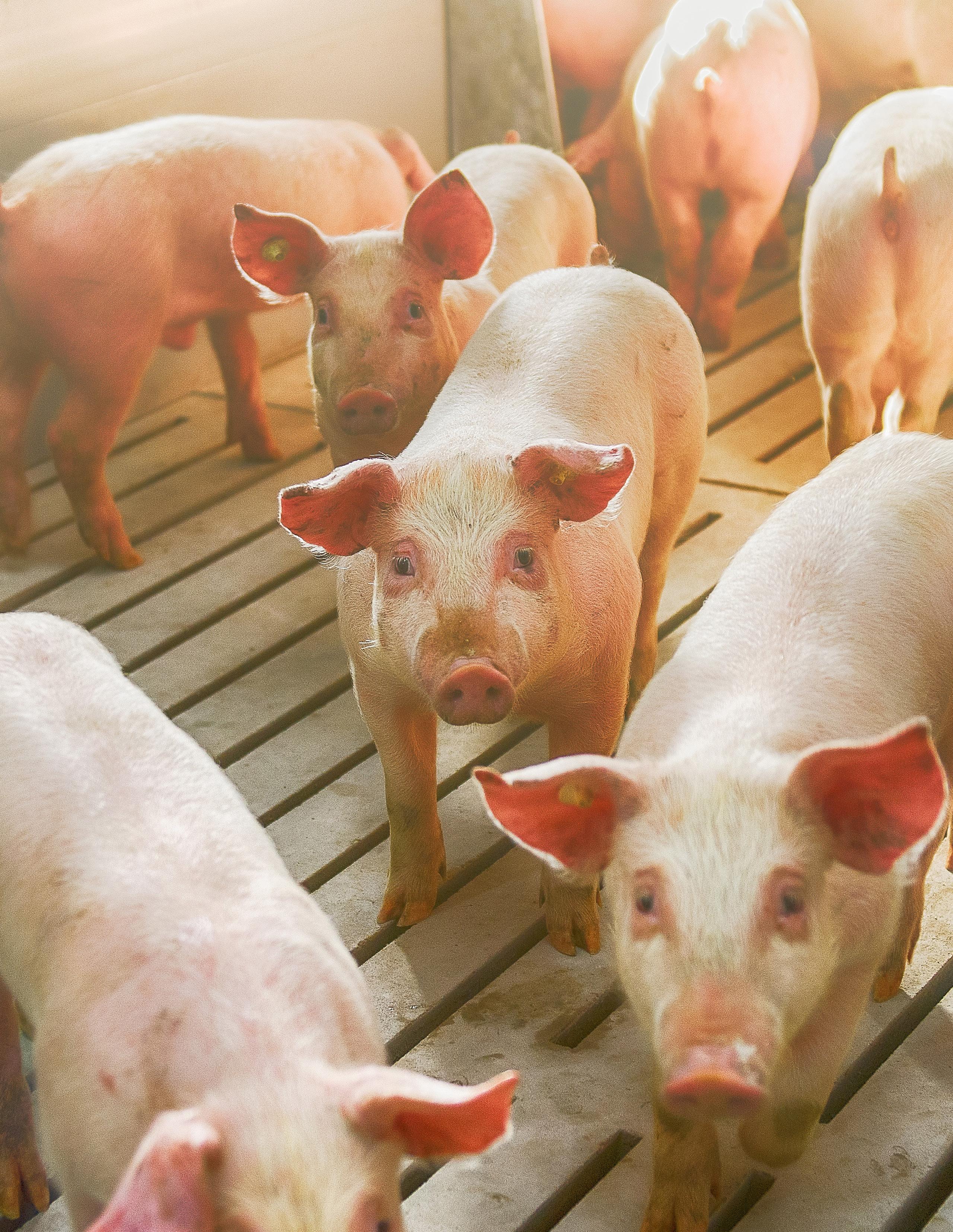
FREE | SUMMER 2021 WPX EDITION PRODUCER Sponsored
IN THIS ISSUE: So What’s Next? Thoughts on the Future of Pork University of Alberta Goldenview: Project Overview Pig Breed Quiz AND MORE!! THE MODERN
By:
FROM THE EDITORS
Hello from the sixth edition of the Modern Producer! We are happy to be producing another World Pork Edition after cancellations the last two years. Glad to see the event back up and running!
With almost half of 2021 in the books, we continue to be blessed by our current clients and we look forward to making new connections as the year progresses.
We hope you enjoy this magazine and the original articles we have compiled over the last six months. Our goal is to share a variety of technology, projects and stories from around the indusrty.
We love this industry and the people who make it what it is. We're proud to be apart of the continured growth and enhancment of the pork industry in the United States, Canada and beyond.
Thanks again for checking out our publication, and make sure to stop in our office(s) anytime for a hot cup of coffee and a conversation.
Sincerely, Tim, Kevin & Kees
New Standard US Tim Kurbis 605-496-9696 info@newstandardus.com
New Standard Ag Kevin Kurbis 204-485-4600 kevin@newstandardag.com


New Standard West Kees (Kase) van Ittersum 403-650-5051 kase@newstandardwest.com

2
3 TABLE OF CONTENTS SUMMER 2021 | WPX EDITION University of Alberta - Barn Remodel So What's Next? Thoughts on the Future of Pork Know Your Breeds? Quiz Born in a Barn? Goldenview: Project Overview ProSort Systems Word Search Modern Hog Barn Infographic 1910 Elementary Agriculture Case of the Meishan Boars Increasing Conception Rates For the Kids: Pig Maze 10 4 12 14 16 19 20 22 23 25 26 24 Produced and Published By New Standard Group Editors Tim Kurbis Kevin Kurbis Kees van Ittersum Design, Layout & Copy Edits 5j Marketing + Design LLC Special Thanks To Hunter Thomas Chet Mogler Tim Friedel Darren Sloan Dillan Meyer University of Alberta Golden View Colony Subscribe or Contribute TheModernProducer.net Advertising Inquiries TheModernProducer.net/advertise The Modern Producer Copyright 2021 All Rights Reserved.
SO WHAT’S NEXT?
are quite a few of
Over the course of our time as a company, we were always curious what the future of farming could be. We sat down with a handful of producers to ask just that. What they enjoy currently, and what, realistically or not, would they like to see in the next 10 years for the advancement of farming. Below are their answers.
HUNTER THOMAS
VP THOMAS LIVESTOCK
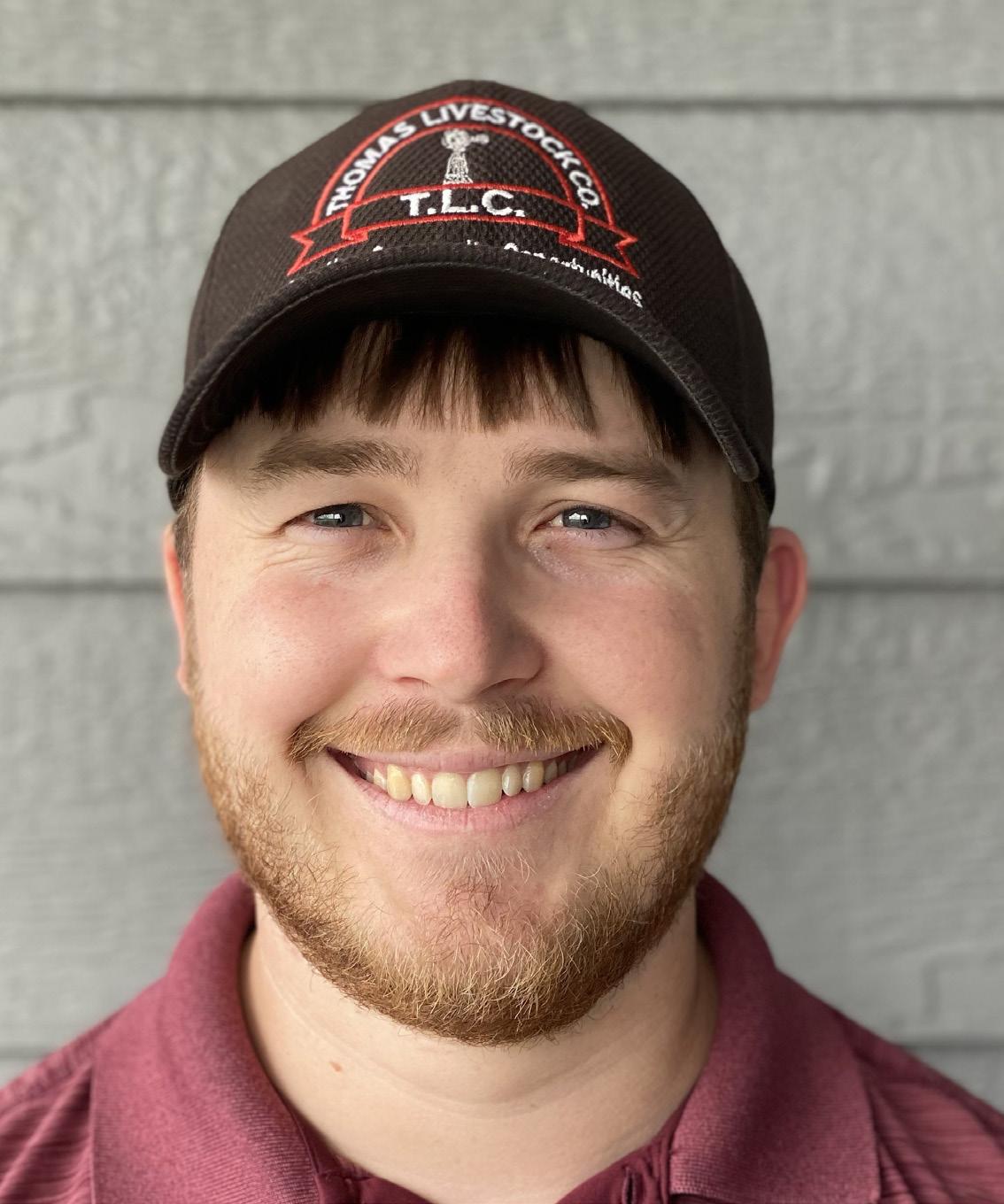
the best environment for pigs and employees to thrive. You can detect problems in barns a lot easier with technology whether it be a broken feed line or water line, ventilation issues, or a sow off feed. Technology has allowed us to focus on what is right for the people and the pigs while increasing our production. The availability of data has helped us be able to make decisions to enhance our production and help us make changes to our barns.
Q: Where do you see things in the next 10 years?
A: I think that over the next 10 years the industry will continue to make advancements in technology. There is still a lot of potential with cameras and integrating what they observe into programs like the Nedap system to provide the pig with exactly what it needs. I do see a couple concerning issues regarding the future, one being unrealistic regulations imposed on the industry, and two being labor. Unrealistic regulations such as Prop 12 will cause more harm than good not only for the industry but for the individual animals as well. Hopefully in the next 10 years we will not have any unrealistic regulations imposed but there will be changes regarding welfare because improved welfare will continue to be popular. Labor has been an issue for a while, but it seems to be getting even more difficult to find help and I do not see that changing anytime soon. Hopefully, the technological advancements in the next 10 years will allow us to adapt to labor shortages and any regulations.
Q: What thing would you want, realistically or not, in the future for producers?
Q: How long have you been in the industry?
A: I grew up in the industry, but I have worked within it part time for 10 years and full time for 3 years now.
Q: How has technology changed the way barns operate today?

A: With the use of technology, you can be more efficient without cutting corners, making sure that you are creating
A: Better prices of course! I would like to be able to see real time data and real time results in all aspects of pig production. I believe seeing that kind of information would help make your business more efficient with production and with employees. I also like the idea of programs communicating together such as Nedap and Pig Champ because it would help keep your data more accurate and again be more efficient.
The New Standard team is all about the advancement of taking care of our animals in this industry. So
the producers we come across in this field.
CHET MOGLER
PIG HILL / MOGLER FARMS
Q: What thing would you want, realistically or not, in the future for producers?
A: There are a few things.
1.The biggest opportunity is utilizing technology to help farm workers to be fulfilled in their job and be efficient as possible. There are certain aspect of animal husbandry that have biological complexity and are limited in their ability to be automated, but we must adapt technology in other areas of the barn where it is feasible. Livestock are living beings. However, being able to utilize technology in other areas of the barn will be key.
2.Capturing all available data points and utilizing the information to establish parameters to warn the caretakers when something is out of spec. These data points may include but are not limited to: photo imaging, illness records, relative humidity, body weight, video analysis to watch pig behavior, temperature and sound.
Q: How long have you been in the industry?
A: Our Family has been raising pigs since 1976. My grandfather looked to the pork industry as an opportunity to bring his kids back to the farm.
Q: How has technology changed the way barns operate today?

A: Many more systems are being electronically controlled, monitored, and connected.
Q: Where do you see things in the next 10 years?
A: Using Mega data to make decisions and real time monitoring.

3. We are in an era where people are becoming more environmentally sensitive. Technology continues to help measure and reduce wastage of water, feed, and other items pertaining to environmental impact. New technologies such as in manure management are going to give us the ability to apply manure at a variable rate. This will help ensure that the soil and crop is getting the nutrients it needs but not more than it needs. It is also important to work hand in hand with government entities toward more comprehensive solutions as compared to regulations put in place that aren’t realistic. We producers want to preserve the ground and resources just like everyone else.
4. One of the challenges with technology is that many companies hold the data they collect as proprietary. This limits what metrics that the producers have access to. Going forward producers will have to work with those companies that are willing to collaborate with others so that the best solution wins.
FRIEDEL
PREVIOUS GENERAL MANAGER THOMAS LIVESTOCK
better, less dust, and noise level was much lower than what we were used to in our barns. This would be better for the animals and our workers. We decided to go ahead with a new large pen Nedap System through New Standard knowing we would have to pay a little more. We felt the reduction of stress would pay off in the long-term with higher production helping to offset the cost.
Q: Where do you see things in the next 10 years?
A: I understand that as an industry we will continue to do more towards animal welfare and the welfare of our employees. However, the problem going forward will be regulations that don’t make sense, such as the California Proposition 12 which would be a step backwards as far as animal welfare is concerned.

Weaning sows into pens is a disaster with sows fighting and crippling each other at a time when they are under stress from weaning anyway. Also Prop. 12 would require penning of sows right before and right after breeding, this means sows would be put in pens while in heat cycle, causing more stress from mounting other sows which can cause injury and reduced breeding results. They key to success and better welfare of the sow is less stress not more.
Q: How long have you been in the industry?
A: I have been in the industry for 45 years, overseeing production at Thomas Livestock for the past 15 years. I am currently semi-retired working 3 days a week.

Q: How has technology changed the way barns operate today?
A: We have 4 sow farms
1st - 5,000 sows small pen group housing, this is an older system over 20 years old.
2nd - 5,000 sows retro from stalls to Nedap about 4 years ago.
3rd – 5,500 sows built with Nedap system about 8 years ago.
4th – 5,500 sows built with Nedap system about 4 years ago.
When we were looking into building our 3rd sow farm, we contacted New Standard and toured a couple of systems they had built with the large pen concept using Nedap Equipment. We were very pleased with what we saw. The animals seemed to be very content and thriving in their environment. The stress level appeared to be very low; sows showed very little signs of aggressive behavior towards each other. Also, the production records at these farms were excellent verifying the fact that a (happy sow is a productive sow). Other things we noticed were the air quality seemed
Our New Standard large pen concept with Nedap electronics has allowed us to be very successful from a production standpoint. Our production numbers from these systems are some of the best in the world today.
Opportunities for camera technology going forward are endless. We in animal agriculture are just beginning to understand what it will be able to do to help us monitor our animals better. Cameras will be able to identify individual animals in pens that may be too fat or too thin, sending this information to the Nedap system automatically could increase or decrease the amount of feed every individual sow would get at all times throughout the sows gestation period. This would potentially allow us to control all sows to ideal weight at farrowing without any additional labor. In addition, cameras could help locate sick or lame sows that may need attention. We could monitor sow behavior to help us understand when we need to change the way we perform a task to help reduce stress on the sows. Cameras could also help define areas where we could improve the tasks our employees do to be safer or more efficient. I believe by having the Nedap System we will be able to transition to using newer technology in the future.
TIM
Friedel Continued
Q: What thing would you want, realistically or not, in the future for producers?
A: Profit, haha.
In all honesty, the Sow System and the technology that is already installed needs to be feasible. ID animals, seeing the conditions of the animal all the way through the weaning. Technology that can automatically be programmed to get the sow to the ideal weight from gestation on through would be ideal. A good system has at least 10 percent or more sows going into farrowing being overweight or underweight. We are getting closer to honing in on getting sows to ideal weight. I believe technology will adapt to New Standard’s installation of the Nedap system. This system is easier than any other type of system.
DARREN SLOAN
BARN MANAGER ONTARIO CANADA

Q: How long have you been in the industry?
A: 10 years back working on the farm. I didn’t have intentions to be farming again. Our parents encouraged us to explore different kinds of employment while I was growing up. I worked with a Roof Press company. I learned to estimate for concrete, disaster restoration recovery. Eventually after getting a degree in Construction Management, I came back to work on the pig farm. Now I am using my previous knowledge of construction to help with our expansion project.
Q:
Where do you see things in the next 10 years?
A: I feel that computerization and monitoring of a lot of mechanical things are going to increase. There can be an increase in little adjustments that could be automated. One example is knowing the temperature in a barn and automatically adjusting. Farmers can spend more time with the volume of animals instead of making adjustments. There is so much more that we can ask from our controller system. Having a system can take the guesswork out of it all. Especially being able to be more maintenance free, as that allows workers to spend time with animals. This can allow future producers to get something done that needs to be completed, or reduce the time spent away from projects.
Q: What thing would you want, realistically or not, in the future for producers?
A: I’ve noticed the quality of automation finally catching up to the environment. When the barn was first updated in 1994, it had a high efficiency furnace, but the other items didn’t stand up in terms of function. My dad ended up taking it out and replaced it with a manual control. Eventually we got a new controller system from New Standard. It is great and versatile. It’s nice to see the computerization and automation working well.
A: Animal wise it would be great to not have to manually castrate male pigs! (Darren chuckles) Everything we wanted to do and change in the barn that was financially feasible, we have done. We have done a treatment of water, where it reduces the build up of iron in the water lines. Lights will mimic the outdoor lightning, making it as authentic as possible. Ventilation systems open and close as the temperatures adjust. We installed a great power washer. We spent three years in the planning phase of the new build. We hope this financial expense will pay off with the pigs we have.
If anything, we would love to see more transparency between producer and consumer. For those outside the industry being able to understand how we take care of the animals and break the preconceived ideas.
Q: How has technology changed the way barns operate today?
Tim
DILLAN MEYER
ACCOUNT MANAGER MCFLEEG FEEDS

Q: How long have you been in the industry?
A: I’m coming up on a decade working in the swine industry and 7 years in poultry (mostly turkey)

Q: How has technology changed the way barns operate today?
A: When I think of “technology” in this regard, I think of mobility/remoteness, automation, and security. The ways technology has impacted livestock production is innumerable.
In terms of mobility/remoteness, I am referring to the ability of a livestock producer today to be able to “manage” or “oversee” a facility while performing other tasks, without physically being there. Now of course technology doesn’t replace a manager being on a farm, the grower still has the responsibility of being there, but these tools can be used to make minor adjustments, that will work until you have time to be back on farm again. This advancement within our production facilities has led to a much greater efficiency level across the entire industry.
When I talk about automation, most producers would argue that our controllers have been automated for years and years, and they would be correct. But today we are on a whole new level. When I watch a turkey finishing facility make decisions on whether or not to ventilate, or at which level (stage) it should ventilate, based on the humidity level within the barn, while taking in to account that it cannot over, or under shoot its temperature set points by more than a few degrees, I am totally blown away at how far we’ve come.
Oh and did I forget to mention while making that decision, it also is taking into account the outside factors as well! So as to not bring in air that is overly humid based on the weather outside, in this scenario. We have curtain sided barns today adjusting up or down not simply on temperature, but raising the side where the wind may be coming from, to slow down a draft over the heads of turkeys. A draft that can start with irritation, and end with a group of sick birds. To top it all off, by setting your controller up properly, most of all of these options/adjustments can and will be made without a human
being present. This type of automation has led to much better environments, which allows the producer to have greater production, and ultimately more freedom to follow up on other areas of importance.
Lastly, I think of security. And I don’t necessarily mean it in the traditional sense of security, however technology greatly improves that kind of security as well. I think of it in terms of having a greater sense of security as the owner/producer, when you are able to pull up a live feed video from within your facility and see that behavior is normal, feed lines are full, and that water lines are being used. We’ve had alarm systems for many years that would call out to your home or cell phone if there was an over/under temp reading, but today’s technology blows that out of the water.
Q: Where do you see things in the next 10 years?
A: Well in the last 10 we have seen quite the changes in barn design, specifically in turkeys. Not long ago you could basically find one kind of Turkey finisher, a curtain sided barn. Now today more and more growers are seeing advantages in what we refer to as a “tunnel barn.” This practice has been common with the swine industry, but is fairly new to poultry. I believe we will continue to see changing ideas on which facility is best, based on production numbers, and of course personal preference. We are already seeing whole facilities being constructed of concrete, or pre-cast walls. And this has been quite the change. Big beautiful, indestructible buildings, that provide a very secure and controlled environment. I believe we will continue to see changes in the building materials used. I could also see facilities and/or sites continue to get larger. With the technology advancements I mentioned earlier, it’s easier and easier to maintain an environment, leading to the grower being able to look after more and more animals.
A: The thing I always pray for in today’s agriculture, is for the growers to have a new found solidarity or unity with one another. There are many outside factors that would like nothing more than to see farming as we know it to come to an end. I believe the only way to combat this type of thing is by banding together. And constantly going above and beyond to educate people from outside the industry, to the level of care and compassion we all have on a daily basis in our livestock production facilities.
We are curious to know your answers. Do you have additional thoughts? Consider emailing our team to be featured on our website and social media. Email us at: info@newstandardus.com. Subject line So What’s Next?
Q: What thing would you want, realistically or not, in the future for producers?

University of Alberta Swine Research & Technology Centre

The University of Alberta, a top 5 Canadian University, was ready to update their sow stall barn into an ESF. They contacted the team at New Standard to begin the design process. By the Spring of 2018, they had finalized the plans. They needed a design for 120 head of sow. The team was in contact with Jay Willis, the Research Stations Manager, Faculty of Agricultural, Life and Environmental Sciences.
The New Standard team started renovations in July of 2020. The sows were moved out of the barn while the team did the installations. They installed 3 Nedap Feeding Stations, a Separation Unit, a Weigh Scale, and a Heat Detection Unit.
Why Nedap

One of the main factors in U of A choosing Nedap as the ESF was for the reporting and tracking capabilities of the system, especially the incorporated weigh scale system.

The data that the Nedap Velos system gathers from weighing and feeding is critical for the research the University needed. The ability to gather data, analyze it, and make changes was important. Using this software allows for the change in variables in the barn. The University can be able to re-evaluate the data, which allows the University to do research projects with the goal to provide producers valuable information that could be applied to their individual farming operations.
Other Equipment
The New Standard team continued installation of equipment during September 2020. Along with the Nedap equipment, they installed PanelTim panels and S.S. post, supplied by New Standard. The team installed waterers as well. They had feed lines and bins installed and supplied by a sub-contractor.
Sows were back in the barn in November 2020. The University was thrilled with the final finished design and set up of the new ESF barn. They enjoyed working with the New Standard West team and Kase van Ittersum. “It was an exceptionally good experience.” The setup and training on the new system went well due to the knowledge of New Standard and Kase especially. Theknowledge of the product and the quick response to questions alleviate any concerns the University had.
The Result
The system is working as promised. The University would not hesitate to recommend New Standard to anyone looking for a great ESF system.
10



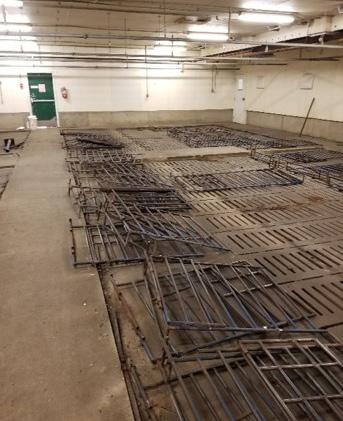




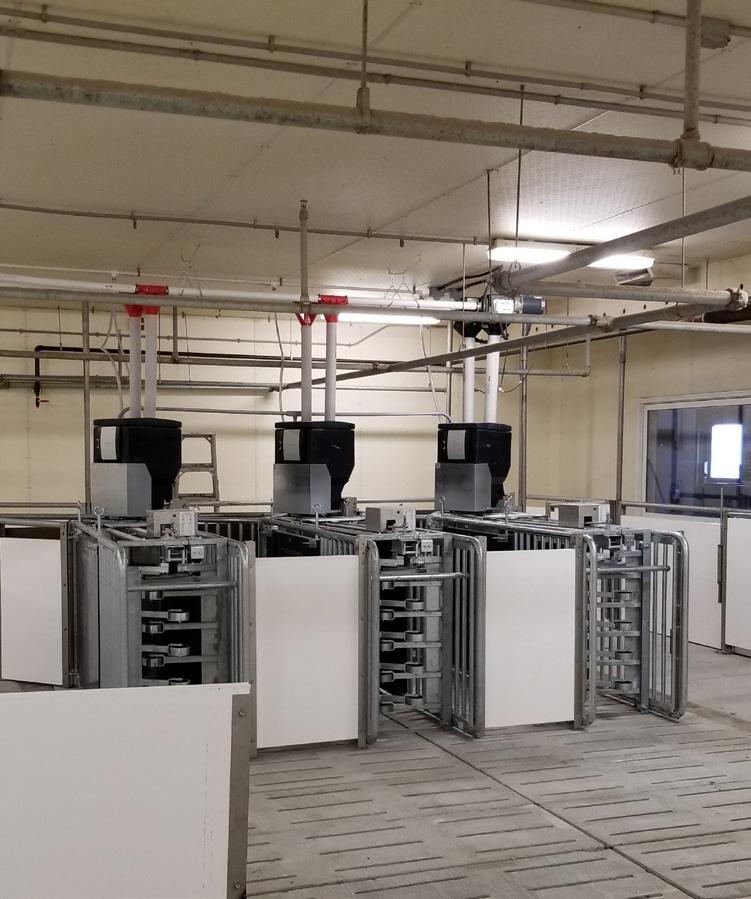
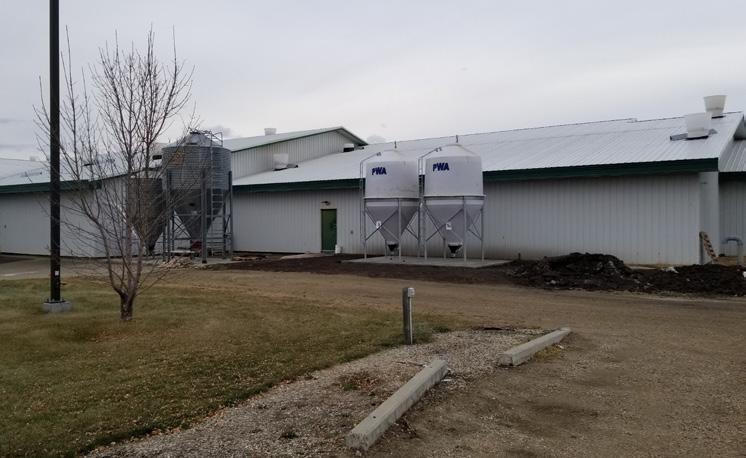
U of A on working with New Standard West
COMPLETE 11
“It was an exceptionally good experience”
BEFORE BEFORE DURING
Born In A Barn?
Please Keep Your Doors Shut
Remember your mother asking you if you were “born in a barn”? Because every time you came into the house you left the door wide open? The expression hasn’t aged well, as old barns don’t hold a candle to modern hog and turkey barns. Our point? your Mom was right, and you need to keep your doors shut.
When New Standard is installing new ventilation equipment or helping get a new barn setup, it is always part of our training to educate farmers on keeping rooms as sealed as possible. Keeping hallway doors propped open breaks this seal and are often the biggest offender. Keeping these doors open has an adverse effect on the ventilation of a room.
Recently we were able to capture this data in visual form thanks to our Fusion control panel. Check out this image, and let us explain what happened so you can prevent this in your barn.

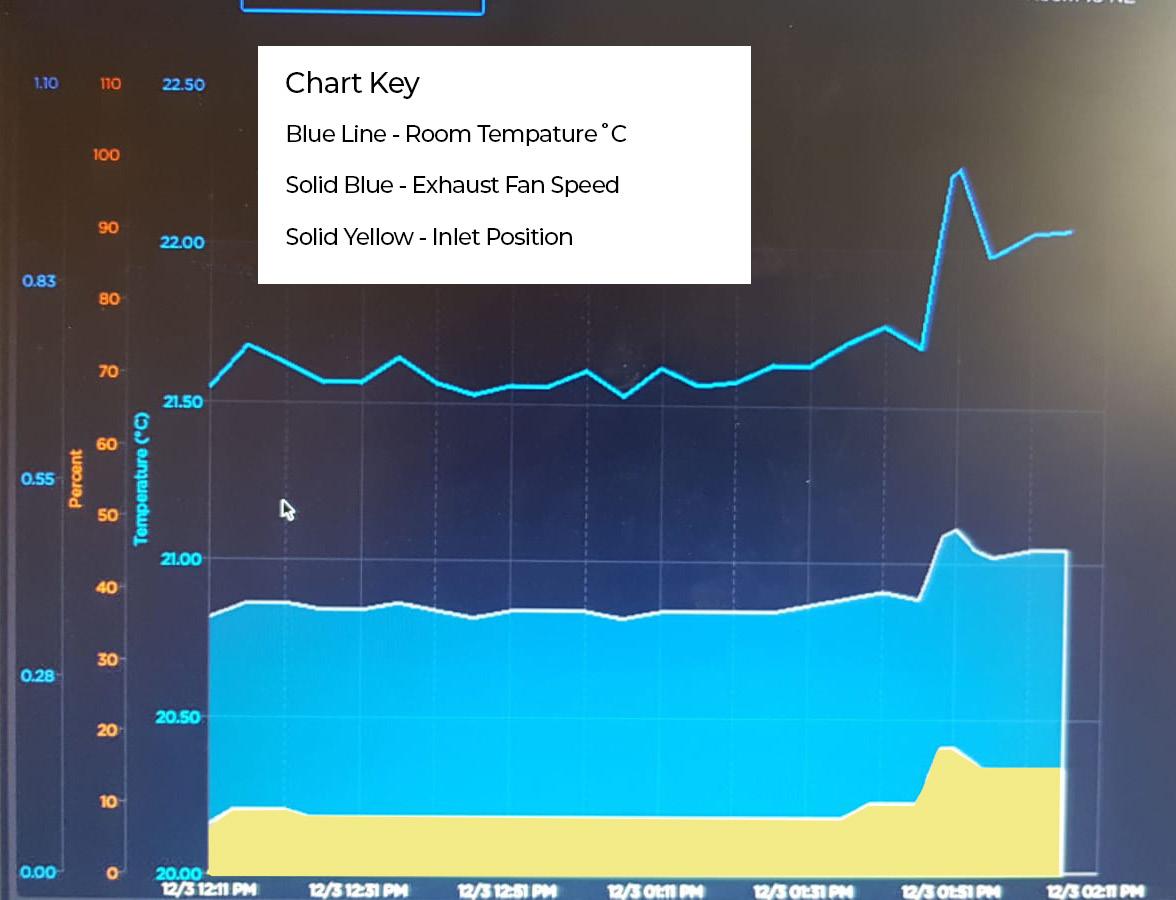
In this example, the door was only open for a few minutes. It only takes five to seven minutes for things to get out of wack.
Fig. 1
In the graph above, the blue line represents actual room temperature, the blue solid represents the exhaust fan, and the yellow at the bottom is the Inlet position. Within the graph, before the spike, we can see that the ventilation is running at a fairly consistent level. Then someone props open a hallway door.
At this point, the room is no longer drawing in fresh air through the inlets but is pulling warm air from the hallway. Like water, the air takes the path of least resistance, and in this case, the hallway’s warm air is causing our temperature to rise in the room.
Fig. 2
As the temperature rises, the fan speed and Inlet position also increase. Once the door is closed after the temperature and ventilation have increased, we suddenly see a sharp drop. At this point we would be drafting the animals due to the increased ventilation because of the temperature rise from having the door open.
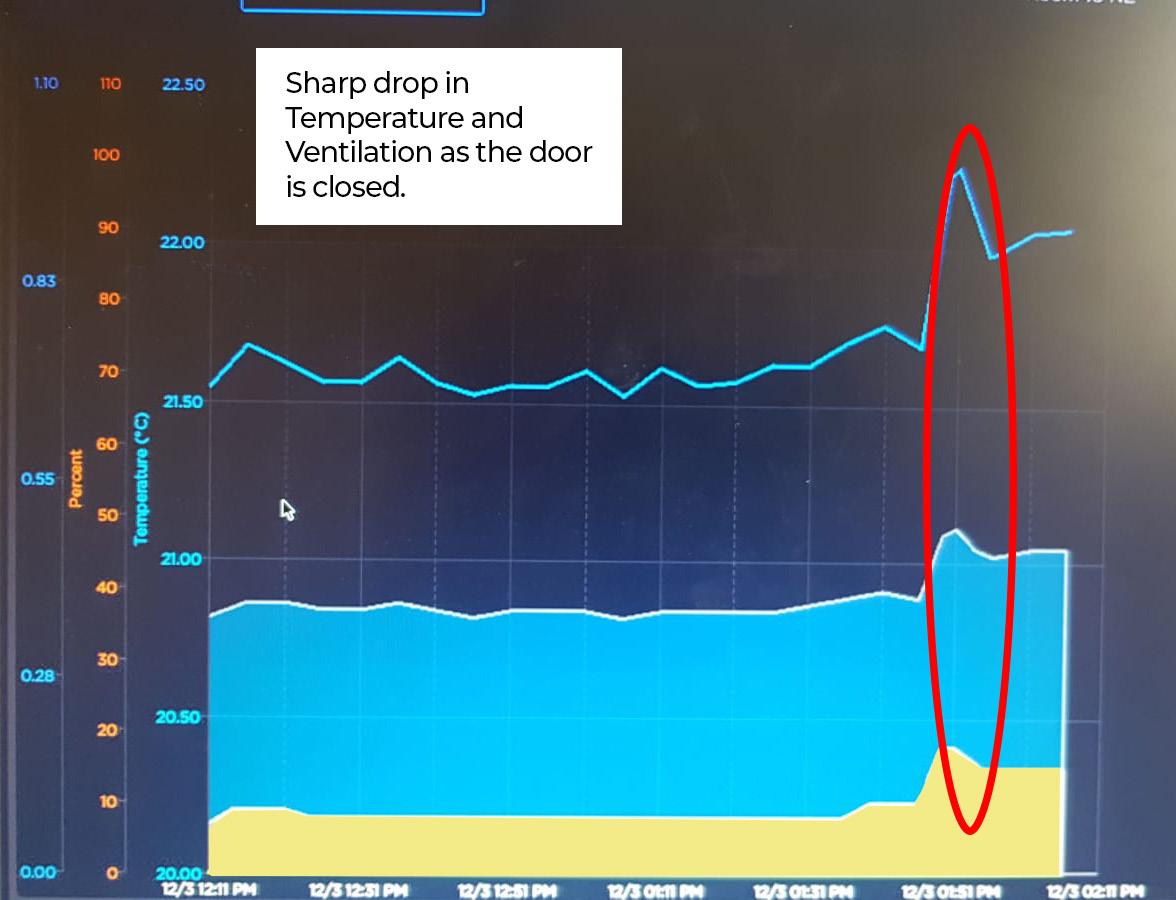
As mentioned, some side effects of merely leaving the hallway door open for 5 minutes can be drafting the animals with cold air and unnecessary ventilation changes that can take a while to adjust to normal fully.
Fig. 3
The solution to these issues is simple, make sure that the door closes behind you, just like Mom would expect.

12


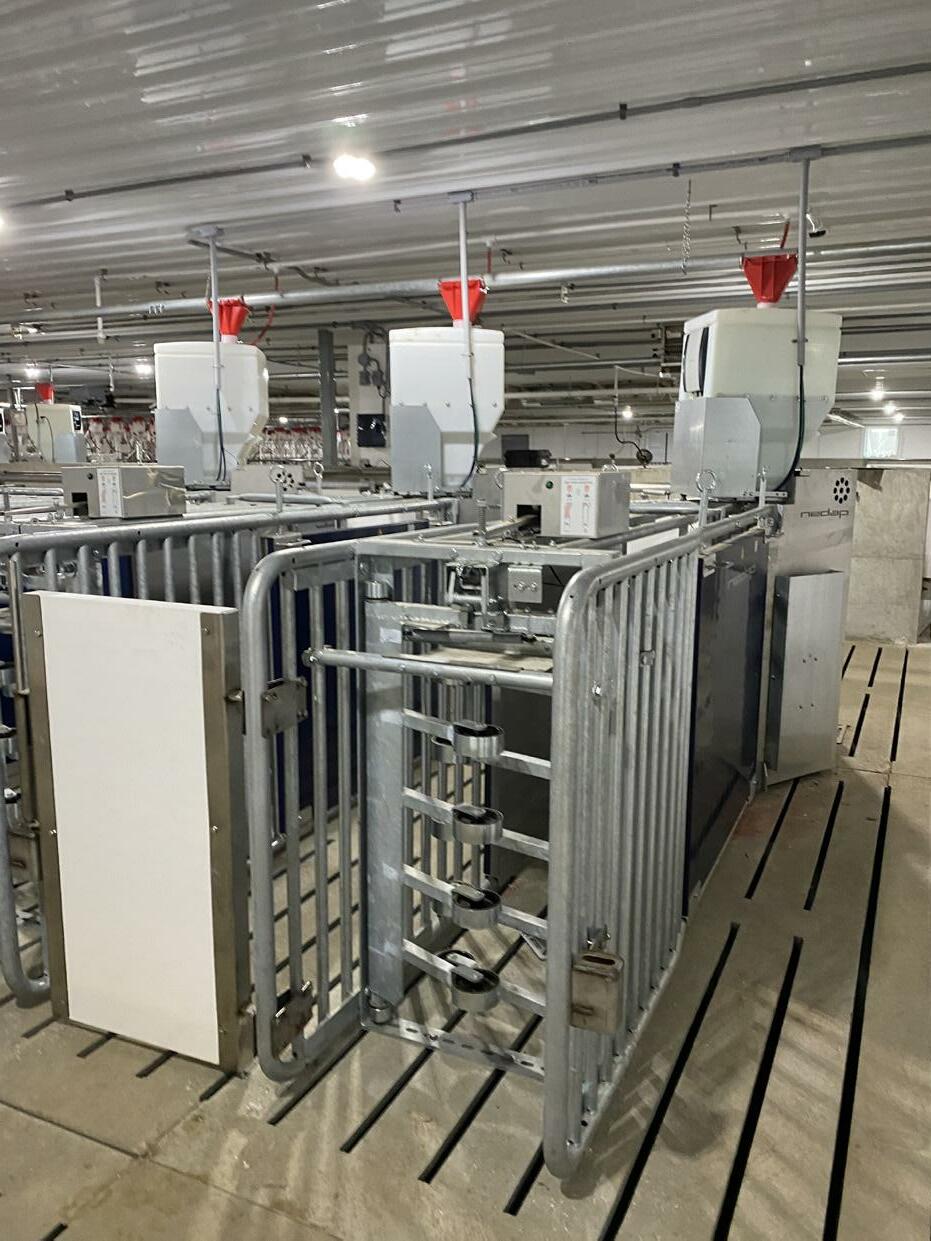
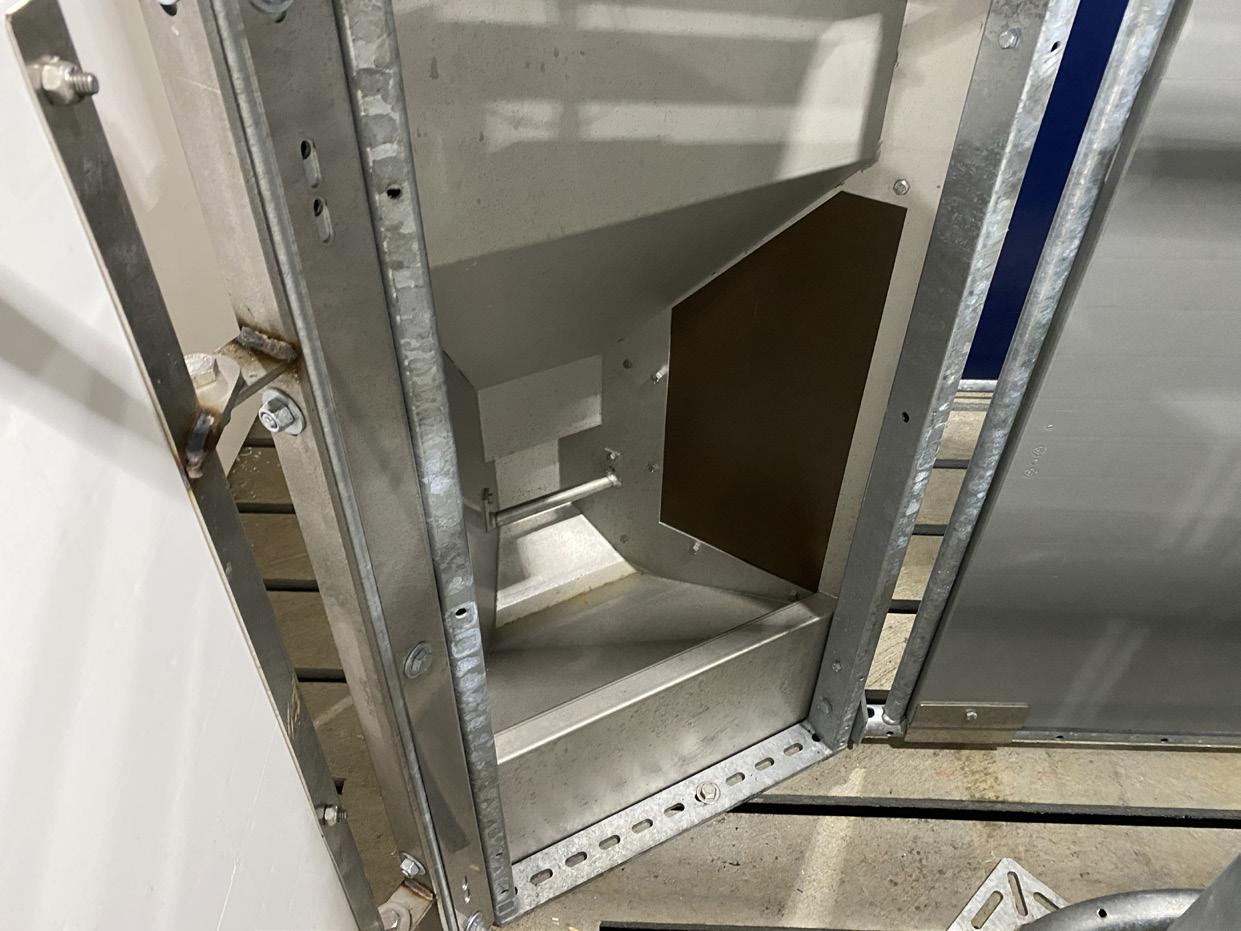






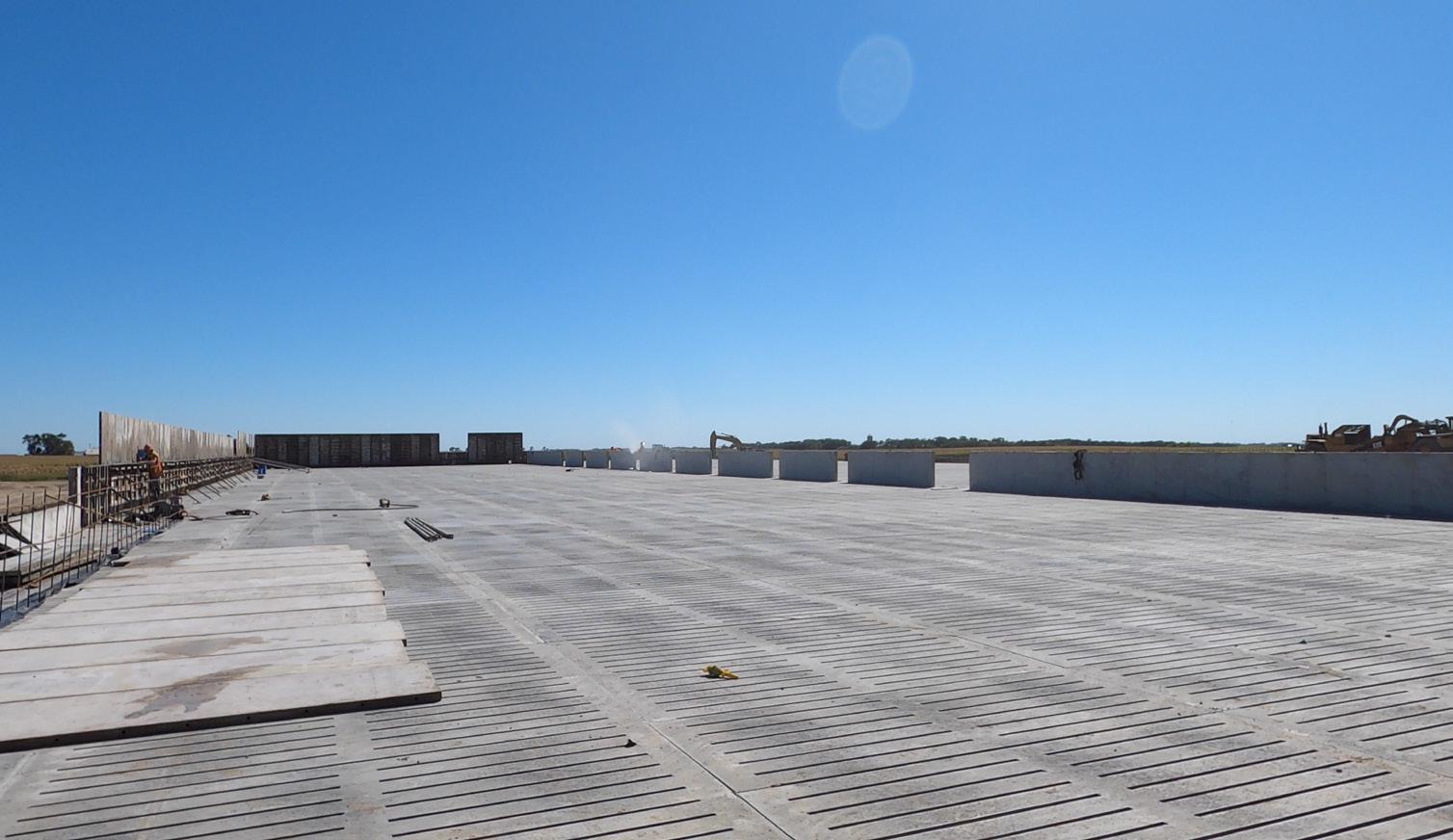
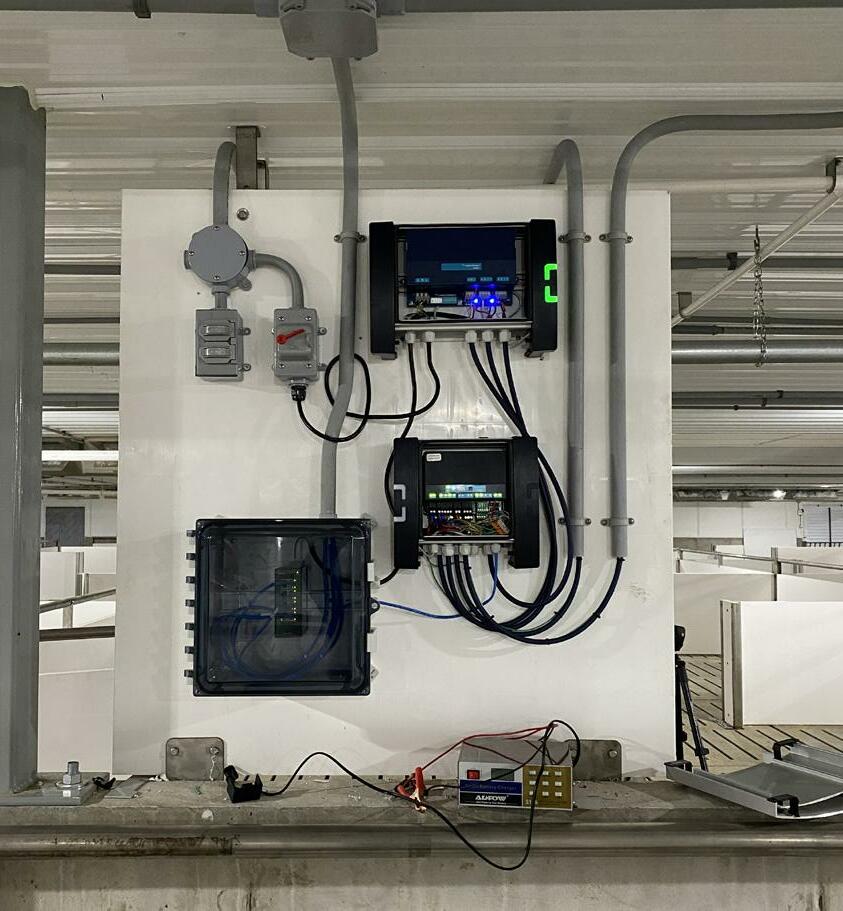
Goldenview A New Standard Project Overview

The team was taken to the small town of Salem, SD to help Goldenview Colony with their new sow barn in August of 2020. We met Michael from Goldenview back in 2014 at the SD Pork Congress. After years of planning and decisions, and a variety of visits from equipment salesman; Goldenview moved forward with New Standard and their use of Nedap ESF systems. The barn was completed in April of 2021. We are thrilled with the project and are excited to see the future at Goldenview.
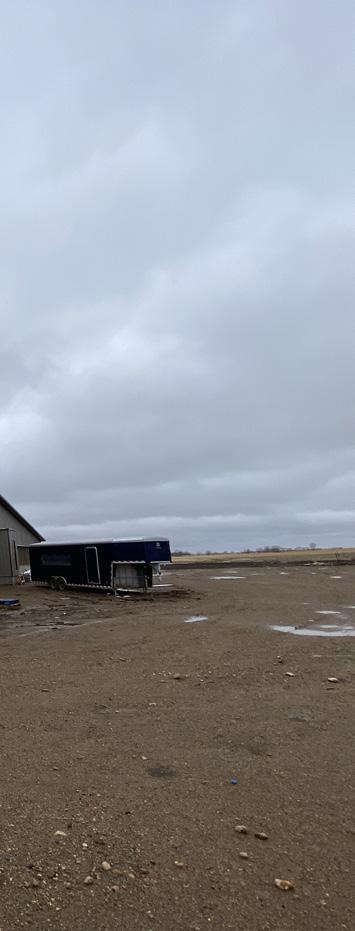
Barn Facts
WS Construction built the barn.
Broke ground August 2020.
Upgrading from 1450 to 2400 head. Previously they had separate buildings for Farrowing and Gestation, meaning, they had to physically transport the sow from one building to another. The barn is designed to accommodate their 2 week batch farrowing.
Farrowing stainless steel crates were made and designed by Goldenview.
April 9, 2021, they brought new gilts to acclimate them on a 14 day matrix.
April 15, 2021, weaned sows were brought in.
Fusion Control system installed.
Gestation
PanelTim nesting installed
3 stations per static sow penning with Goldenview common exit design with the help of New Standard to construct it.
Batch farrowing every two weeks, the team installed 8 total sow pens. 150 head of sow to 1 pen.
2 Dynamic Gilt pens. 5 Nedap Feed Stations with central separation.
2 Goldenview style watering bowls per pen
1 Separation unit per gilt pen
Extra Gate installed with rod gating to treat a sow one on one while allowing the sow to interact with the other animals (in pen special care area)
Concrete and slats from Westwood Colony

Farrowing
52 crate farrowing rooms: 4 rows of 13 in each room Nooyen flooring installed
Turn around farrowing crates constructed in stainless steel by Goldenview
Millerdale feeders installed
Double heat lamps installed
PWA inlets installed
AP Heaters
PanelTim paneling
Other Features
2 Long Narrow Gilt Nurseries on the north end by farrowing
2 Gilt Grower rooms on the south end
ESF Training Room
Construction and Manufacturing
160 foot wide barn
GDU-two stage grower that transitions into the gestation area

EPS Building using SIPS panelling
Munters Fans- for ventilations (Munters drive installed)
Double L flooring installed in the nursery area
Cool cell banks installed against both sides of the barn, and gable ends due to size of building
Pre-Training station built for gilts being acquainted to Nedap system
Offices installed with utility space and 3 stall garage Section installed for cull load out
Dead stock vessel dock with stainless steel vessel for mortality to be moved out
Fun Facts
Goldenview used a mixture of water and apple cider vinegar to spray down all the new cement to reduce new barn disease in animals. This mixture is to neutralize the caustic nature of new cement. Breeding stalls had pig easy meal meters installed, and all stalls were constructed by Goldenview themselves.
Reason for Nedap: they had a variety of salesmen out trying to sell their equipment to Goldenview. Ultimately, Nedap was a winner due to: Running bigger groups, which Michael really wanted Walk around the Horseshoe style pens.
Forward exit allowed for a smoother transition
Water added to feed: reducing the stress on the animal, and reducing competition in animals.
Scan for a Video Barn Tour Tour the Barn with Tim & Michael on YouTube
ProSort Systems
A Smarter way to finish hogs
ProSort Systems has been designing equipment for modern hog barns for the last fifteen years. With a potent mix of experience, passion for doing things right and innovative technology, ProSort has become the world leader in hog sorting systems.

It all started in 2005 when we received a request to make some hog sorters from a neighbor. After some research and checking out competing products, we came to the conclusion that we could provide a better overall product and experience for our customers and for the pigs.
In 2018, looking to make our products even better, we met with an animal behavior specialist. He got down on his hands and knees and crawled around our sorter for over an hour. After his inspection, he explained how a pig might feel as it used our equipment, cramped and uncertain, as well as nervous and anxious. This was a
process from the ground up. The results have been excellent.
With most finisher sorter barns, your average daily weight gain typically drops at first. Not with the new ProSort Systems. The “pig lineup” is eliminated as pigs are no longer hesitating to step off the scale and move through the dividers, speeding the process up significantly. A pig should be able to move through the gate and eat when she’s hungry, quickly and smoothly; ProSort accomplishes that.
Today our sorters are the best in the industry, proven with trial and error and in barn real-world testing. Our sorter helps eliminate the lag and line up; the pig needs to eat when it’s ready. On top of that, our proven systems help save producers money, positively affecting the bottom line.
Our sorter weighs each pig and sorts it based on its weight. If the pig is below target, she gets a high protein ration, if she is above weight, a low protein, and a normal protein ration at target weight. By automatically sorting pigs and splitting up the protein amount in each ration, you save on average $15 per ration.
ProSort Systems also saves producers money in removing the task of sorting out pigs for the market when they are at the correct weight. As the pigs approach market weight, they are automatically sorted into the loadout pen, eliminating time and effort to get the right pigs on the truck. Again, saving you time and money.
So, we ask, if you could gain $4.50 more per pig by using a ProSort System, would you be interested? We think so! We’d love to answer your questions and share more about our products and solutions. Bottom line, ProSort Systems help you efficiently finish pigs while saving you money on rations; we’d call that a win-win.

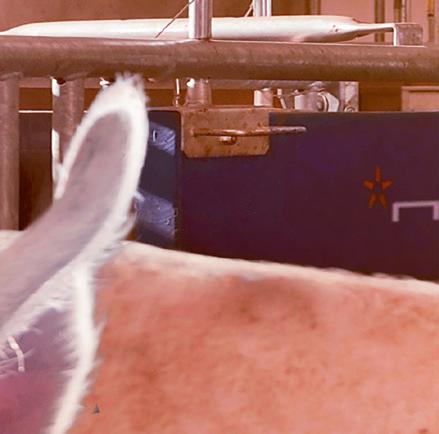



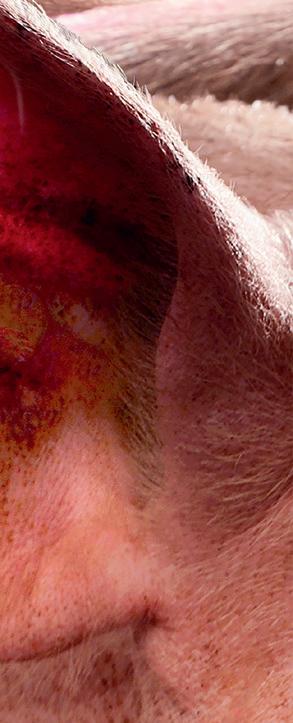



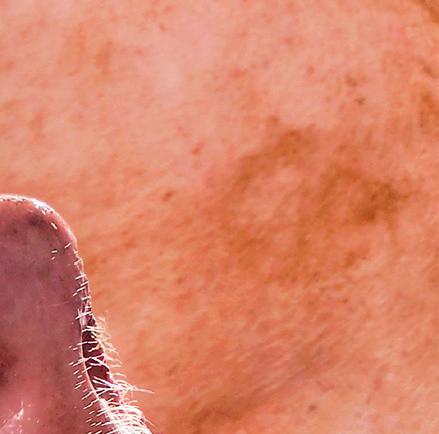
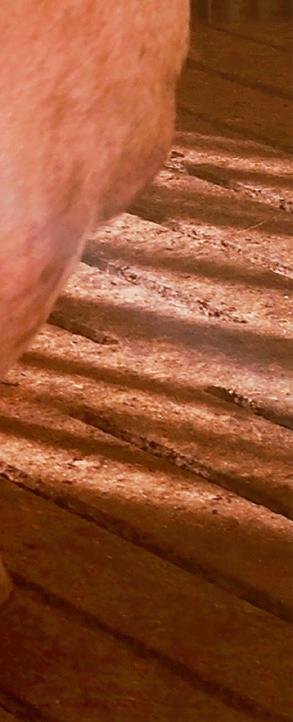



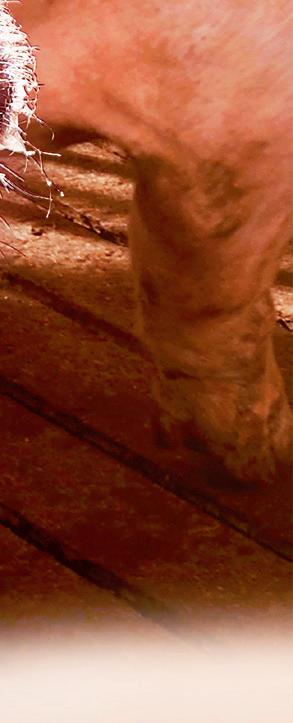




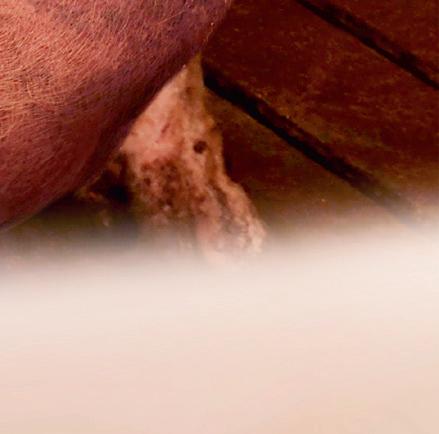









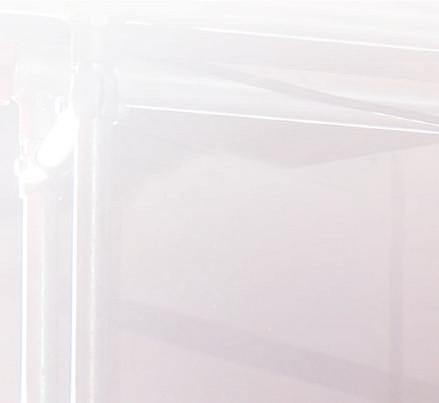







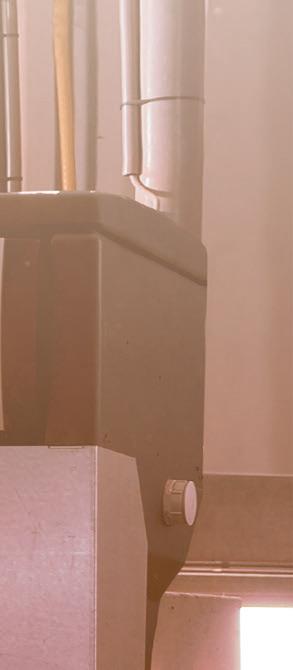

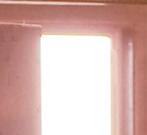







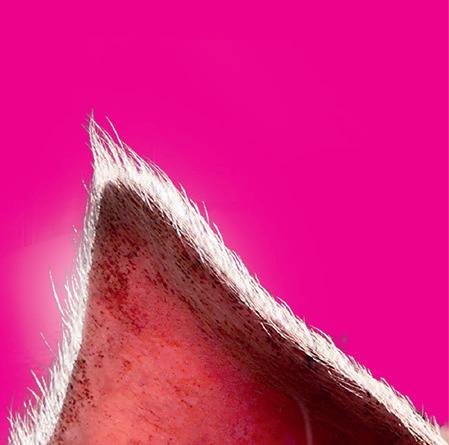


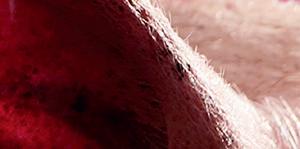
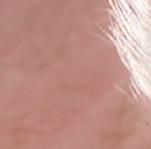

















Electronic Sow Feeding Searching for a solution to CA Prop 12? Find Nedap in booth V525 to learn about Group Housing solutions! nedap.com/pigfarming For more information contact our team: (712) 435-7546


19 W_RD SE_RCH TROTTERS KNUCKLES PANCETTA CROWNROAST ROASTS BOSTONBUTTS CHOPS HAM CUTLETS LARD SPARERIBS SAUSAGE TENDERLOIN BACKRIBS HOCKS SHANKS BACON PORKBUTT SHOULDER
A Modern Hog Barn
Loose Sow Housing with Electronic Sow Feeding
Barn Flow
The design of a modern hog barn is all about the animal. The more comfortable, safe, and happier the sow, the more productive she will be in regards to producing healthy o spring.
Sows need a few things. Food and Water, Security/comfort, social outlet /normal behavior, comfort, freedom from fear or distress and a place to relieve themselves. Here is how the barn design helps meet those needs to keep the sow happy.
1. Food and Water - Feeding is taken care of via the Electronic Sow Feeders or ESFeach animal is given a pre determined amount of feed based on weight and other factors. Water is provided with the feed and through the pen.
2. Security/Stress Free - Each feeder is it’s own contained area. Allowing for only one animal to feed at a time. This gives each animal a stress free feeding time and stops competition and ghting for rations.
3. A forward exit from feeders prevents competition and ghting between full and hungry animals.
4. Social Interaction / Normal Behaviorthe open pen design allows for sow to interact with each other. Just like humans, sows are very social animals. They have “friends” and even groups of sows they spend time with.
5. The slatted ooring allows for any waste to fall into the pit below. This keeps the pen mostly clear of waste and giving animals any places to rest without becoming dirty.
Slatted Floor
The ooring is full of open slots. These slots allow manure and waste to fall through the oor to the sewage pit below the barn.
RFID Tags
5Each pig is tted with her own Radio-frequency identi cation or RFID Tag that is attached to her ear. This tag allows farmers to individualize and nd each animal. It also allows for tracking the animals, feeding, weight, heat and more.

20
Nesting Area
Modern barns often include designated areas for sows to laydown or rest. Often sows will gather together in these areas in between feeding.
Water
Watering nipples or bowls are placed throughout the barn.
Wi Internet
Internet is what helps make this all possible. Barns are equipped with many wi antennas to allows farmers to see what is going on from anywhere.
Alley
Path for farmers to use to access areas of the barn.
Boar Pen
The use of a boar pen is to allow sows to interact with the boar (male), and to help detect who is in heat.
Heat Detector
If a sow is visiting the boar, there is a good chance she is in heat. The heat detector lets the farmer know who is ready for breeding.
Separation Alley
If an animal is in heat or if other issues such as an injury or illness are detected, sows may be separated out into the separation alley to be easily accessed by the farmer.
Scale
As the sow exits the feeders, in some cases she will pass over a scale which will weigh the sow.
Electronic Sow Feeders (ESF)
ESF barns have electronic sow feeders installed. These units will only open gates and allow sows to feed within certain time frames. Feed amounts are also automated based on an animals needs, water is also available with feed.
21
1 2
3
4

22 KNOWLEDGE TEST KNOW YOUR BREEDS? How well do you know your pig breeds? Test your knowlege below! Match the pig with the breed! Answers on Page 26 __ Hereford __ Hampshire __ Tamworth __ Duroc __ Poland China __ Gloucester Old Spot __ Yorkshire __ Chester White __ Meishan __ Danish Landrace __ Vietnamese Potbelly __ Mangalitsa __ Large Black __ Berkshire __ Kunekune
1910 Elementary Agriculture
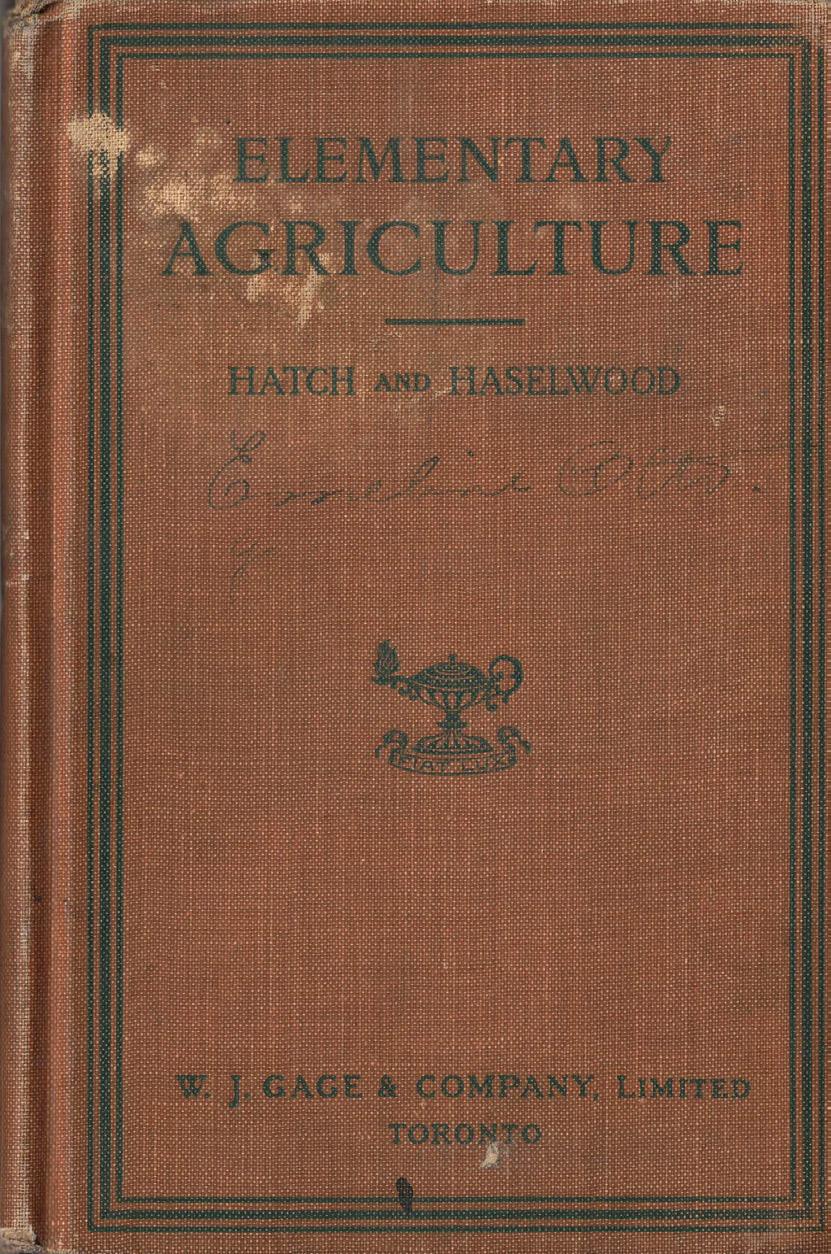

What a time to be alive! This was given to Kevin by his mother. She found it while cleaning up the attic of the farmhouse (it’s the same house that his dad lived his entire life). This book was filled with goodies that can still be appreciated today.
The front cover of the textbook had the name “Emeline Otto” written on it which is the name of Kevin dad’s mother (maiden name). The inside of the cover had John Otto scratched off and then Emeline Otto written on it. John was the older brother, so the assumption is, she was given the textbook once he was finished with it.
This textbook was copyrighted in 1910, which would have meant, Kevin’s grandparents were in elementary
school! At the time, study of agriculture was part of the mandatory school curriculum. The idea being, to educate kids in the concepts of farming and how they are tied to math/arithmetic.
Barn Plan and Ventilation
One of the chapters is the focus of “Barn Plan and Ventilation” (see below). They talked about the importance of space, and provided some space saving remedies for barns. Some options were placing bins and chute feeds elsewhere. Opting for doors on hinges instead of on rollers.
One of the things that they stressed is a common thing we also stress, especially here at New Standard. We always remind producers of the importance of Proper Ventilation. In this textbook they state that “in our efforts to provide warm and comfortable quarters for our stock, we have overlooked, in many cases, the important matter of all-proper ventilation.”
Now, modern barn ventilation is more tech savvy than it was back in 1910, but it’s interesting to see what their options were back in 1910. As you see the infographic (page 20), their options are presented in this textbook. See images to the left.

Plan for a Ventilated Barn
In the textbook they discuss the “neglected feature of barn construction is deemed worthy of special mention”. Isn’t that the truth? We have many articles about ventilation in your barns, and it’s still true even from 1910. Now, although the way ventilation is equipped in a barn is different from 1910, it’s interesting to read their theories.

THE CASE OF THE MEISHAN BOARS
Since their introduction to the United States in 1989, the Meishan breed of pigs has developed quite the reputation. We’ve heard some fun strories over the years and our 10 year’s interviews, we surveyed the producers to see if they had anything to share, here is what we got.
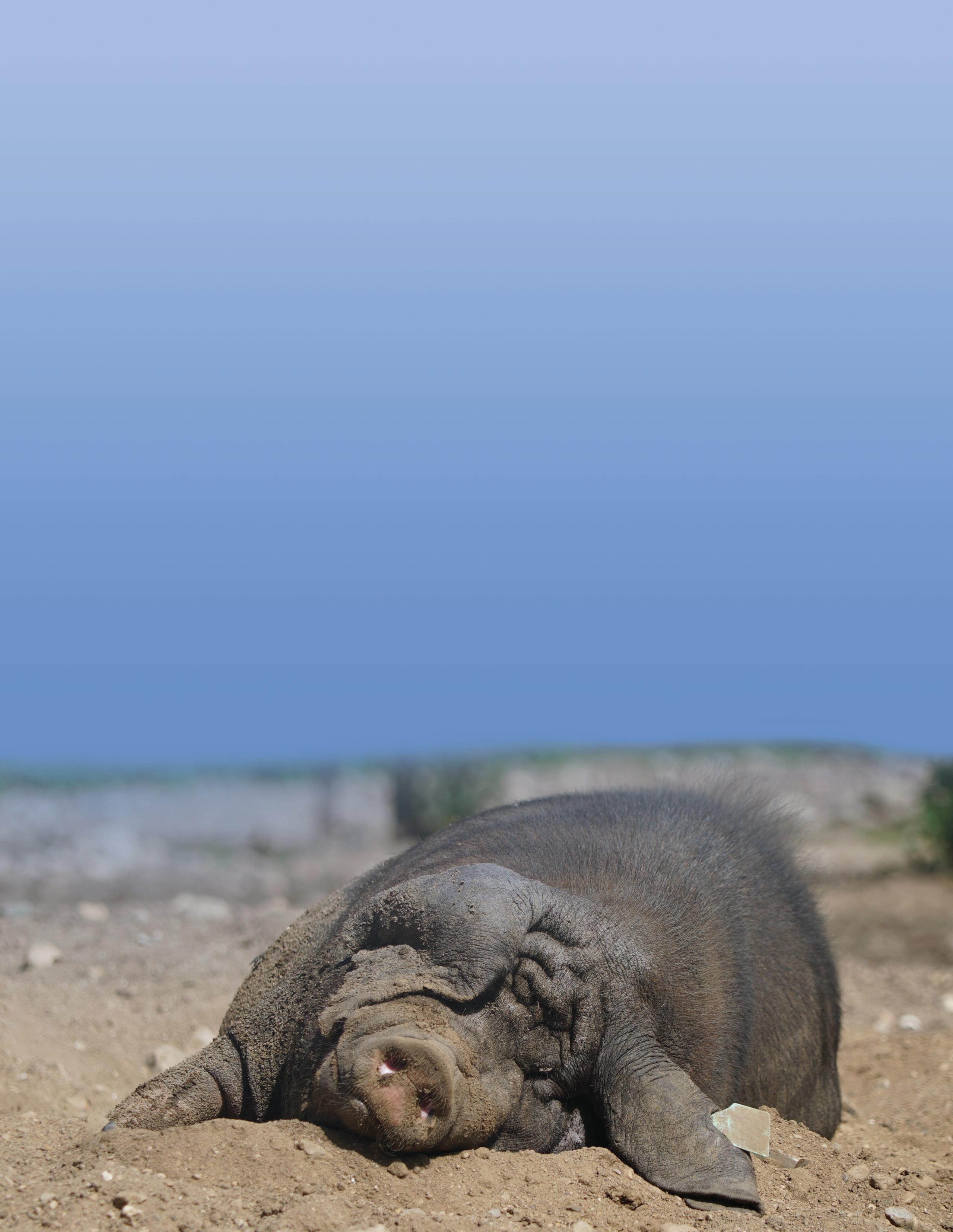
“They are inquisitive animals, and they are also Houdinis. They will work their pins out of the pens and roam. That is why, back in the old days, they had placed nose rings on them to stop from rooting. The nose rings would prevent them from rooting and working the pins out of their pens. It helped guys spend less time unbending the pins. They are great for giving pheromones off to stimulate the females, and stimulating animals for breeding. They are not pretty to look at, and not great to eat, but they are sure stimulating.
~Darren Sloan
“Meishan boars are used to stimulate gilts that are not cycling right. We found one of the gilts was pregnant. We discovered that a vasectomized boar was getting the gilts pregnant. We realized the boar wasn’t vasectomized correctly. So moral of the story, check your boars before using them for stimulation.”
~Chet Mogler
“Meishan boars that we use are half the size of normal boars. We use them to tease sows while breeding, but they are ugly things.”
“They are super resourceful, but definitely not something to look at.”
~Tim Friedel
“The only thing I have about meishan pigs is every single time I see one, all I can think is, you are so darn ugly you’re actually cute. Haha. Horribly ugly creatures.”
“But they serve a great purpose in sow farms everywhere. Much easier for the producer to deal with a boar that stays smaller in stature!”
~Dillan
24
INCREASE CONCEPTION RATES WITH SIMPLE CHANGES
A few weeks back, we had one of our clients stop by our Sioux Falls office for a cup of coffee. As we began visiting about the state of things in his barn, the topic of conception rates came up as our client had just recently started implementing our suggested strategy for introducing bred sow (gilts) back into the pen. His results were so surprising and wonderful, he asked why we hadn’t forced him to do it this way months ago!
What you need know.
This is not a shortcut or easier process, it does require more time spent with each group that you are re-introducing. Timing is critical as getting the girls “settled” before implantation begins is really the key.
It is best to set up the flow of any particular pen to fill or “roll over” the population in the pen in a 12 – 18 day time frame. With this flow of animals in place, the sows that are late-term pregnancies will largely remain segregated by choice from new entry animals. This is largely because sows and gilts will establish social order and grouping shortly after introduction to a pen, and this structure will remain in place for as long as the girls are together. Understanding this is key to making a pen work and understanding why problems may arise if the introduction is mishandled.
We have found that when a pen is put into flux and sows are taken out to go to farrowing while new sows are introduced, the pen should remain in flux until the “roll over” is complete. If a pen is allowed to stratify by remaining in a static position for more than 2 -3 days, social groups will begin to develop amongst the new entries and when more animals are brought in, disruptions occur within the social order and cause undue stress.
Likewise, undue stress can also occur in the first hour or two after re-entry as the sows try to find a place to fit in. During the first hour or two after re-entry, a person should remain with the girls to sort out any issues that may arise.
One of the other key elements for a successful introduction to a pen is to make sure every new animal is reminded where the feed is and how the feed system works. Our recommendation is that a new group of sows brought to the pen be taken to the entrance of the feed station and allowed
to enter (and eat if desired) before going into the general population.
So what is this process? We’ve broken it down into eight steps you can take.
1. Plan to introduce new entries in hour(s) 16 -21 of a 24hour feed cycle.
2. Group sizing should be at least 8 sows but no more than 15 girls as managing more than that at once can lead to shortcuts being taken.
3. It is possible to introduce two separate groups into a pen in one day if the total doesn’t exceed the holding capacity of the separation when it is time to go to farrowing.
4. Feed the girls in the breeding stall before moving to the pen.
5. Upon moving to the pen, you can allow the girls to settle down for about 10 minutes in the separation area as they will have gotten a bit excited on the move.
6. When entering the pen, you can either take the shortest route to the feed station entrance and hold the girls in the general area until they go into the feed station, or some barns do walk the length of the pen with the girls to get them to the feed station entrance. This is somewhat driven by layouts as well as genetic variations. The more docile your girls, the more likely that walking the length of the pen will work. If your girls tend to be a bit more aggressive, it is recommended that they be taken by the shortest route to the ESF entrance before meeting their neighbors.
7. As the sows pass through the feeders and exit into the general population, someone should be on hand to sort out any competition that may occur.
8. If any competition does occur, it tends to happen between animals that are either new entries or day-old entries. When everything is flowing as scheduled, a vast majority of sows will have become a well-adjusted part of the pen by day 3. Therefore, it is important to schedule the re-entry as soon as the heat is over to allow adjustment prior to implantation.
Results.
So now that we’ve given you more to do, what sort of results should you expect? We’ll we’re gonna hand it over to Keith Waldner to answer that.
25
“...our conception rates jumped to 92-96% consistently”
Continued on Page 26
-Keith Waldner
“Before the changes, our farrowing rate ranged anywhere from 65% to 90%; very inconsistent. After implementing Tim’s suggestions and some tweaking our conception rates jumped to 92-96% consistently.” Exclaims Keith.

Wrapping Up
There is a method to our madness. There is so much more to raising pigs than your barn’s cost or the newness
of your equipment and technology. All these things are great and help us be successful producers, but we need to continue to answer and ask the “why” question at the end of the day. When we do we are ofter met with new ideas, fresh concepts and strategies that not only help our bottom line but keep our pigs happy and healthy producers.
Pig26 Breed Test Answers BHereford HHampshire JTamworth DDuroc MPoland China AGloucester Old Spot FYorkshire IChester White LMeishan GDanish Landrace OVietnamese Potbelly CMangalitsa KLarge Black EBerkshire NKunekune
START FINISH
Continued from Page 25



28 www.newstandard-group.com New Standard has three regional offices to bring their expertise in sow and poultry housing directly to you. New Standard US Tim Kurbis: 605-496-9696 info@newstandardus.com New Standard US 1200 E Robur Dr. Sioux Falls, SD 57104 New Standard Ag Kevin Kurbis: 204-485-4600 kevin@newstandardag.com New Standard Ag 961 Harriot Rd St. Andrews, MB R1A 4H6 New Standard West Kees (Kase) van Ittersum: 403-650-5051 kase@newstandardwest.com New Standard West 243159 RGE RD 281, Rocky View County, AB. T1X 2C4


















































































































